The best geothermal heating automation system depends on your specific needs and setup. Top performers include Carrier's Infinity Control, ClimateMaster's iGate Connect, and WaterFurnace's Symphony platform. These systems offer smart features like remote access, energy tracking, and zone management. When choosing, consider compatibility, desired features, and long-term support. Smart thermostats and energy monitoring tools can greatly enhance efficiency and comfort while reducing costs. Proper installation and maintenance are essential for peak performance. By selecting the right automation system, you can maximize your geothermal heating's potential and enjoy considerable energy savings. Exploring the options further will help you make an informed decision.
Understanding Geothermal Heating Automation Systems
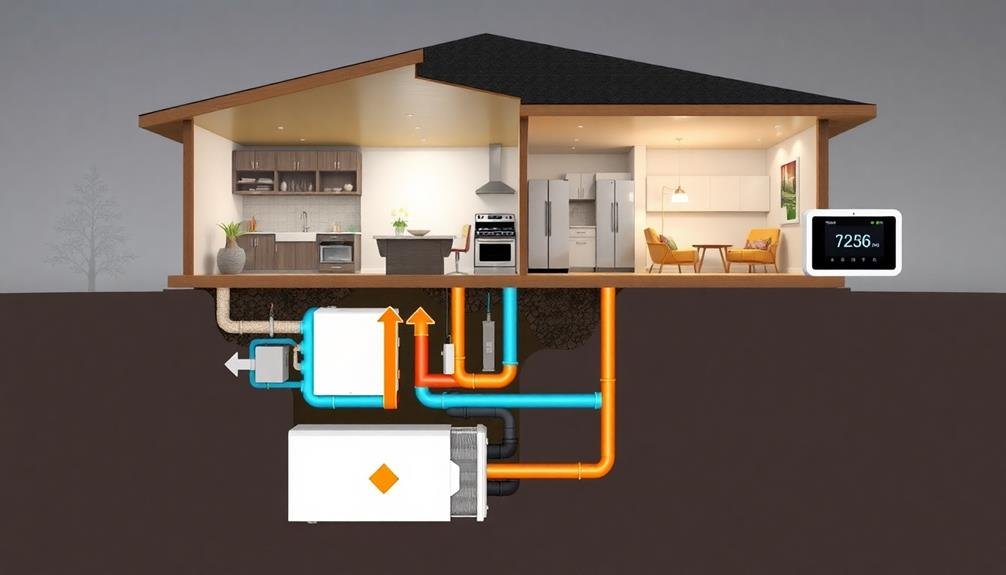
While geothermal heating has been around for decades, automated systems have revolutionized its efficiency and ease of use. These systems integrate smart technology with geothermal heat pumps to optimize your home's heating and cooling. You'll find that automation allows for precise temperature control, energy usage monitoring, and remote access via smartphone apps.
At the core of a geothermal heating automation system is a smart thermostat. It learns your preferences and adjusts temperatures based on your schedule, weather conditions, and occupancy. The system also includes sensors throughout your home to detect temperature variations and humidity levels, ensuring consistent comfort in every room.
You'll benefit from features like zone control, which allows you to heat or cool specific areas independently. This targeted approach can greatly reduce energy waste.
Additionally, automation systems often incorporate predictive maintenance, alerting you to potential issues before they become major problems.
When choosing a geothermal heating automation system, consider compatibility with your existing setup, user-friendliness, and integration capabilities with other smart home devices.
Look for systems that offer detailed energy reports and suggestions for improving efficiency to maximize your geothermal investment.
Key Components of Automation Setup
You'll find that control systems form the brain of your geothermal heating automation setup.
Sensors and monitoring devices act as the system's eyes and ears, constantly collecting data on temperature, pressure, and performance.
Smart thermostats serve as the user interface, allowing you to easily adjust settings and optimize your home's comfort and energy efficiency.
Control Systems
The heart of any geothermal heating automation system lies in its control systems. These sophisticated components orchestrate the entire operation, ensuring ideal performance and energy efficiency.
You'll find that modern control systems typically include programmable logic controllers (PLCs) or microprocessor-based controllers that manage various aspects of the geothermal system.
These controllers monitor and adjust vital parameters such as temperature, pressure, and flow rates. They're designed to integrate with sensors throughout the system, collecting real-time data to make informed decisions.
You'll appreciate their ability to maintain precise temperature control in different zones of your home or building.
Many advanced control systems now offer remote access capabilities, allowing you to monitor and adjust settings via smartphone apps or web interfaces. This feature proves incredibly convenient for managing your geothermal system from anywhere.
When selecting a control system, consider its compatibility with your specific geothermal setup and desired level of automation.
Look for systems that offer user-friendly interfaces, customizable programming options, and robust diagnostic tools.
Don't forget to factor in the system's ability to integrate with other smart home devices or building management systems for a truly cohesive automation experience.
Sensors and Monitoring
Sensors and monitoring devices form the foundation of an effective geothermal heating automation system. They continuously collect data on various parameters, allowing you to enhance your system's performance and efficiency. You'll need to install temperature sensors in different zones of your home, as well as in the ground loop and heat pump. Pressure sensors monitor the fluid flow in the system, while humidity sensors help maintain ideal indoor comfort levels.
Flow meters measure the rate of fluid circulation, guaranteeing proper heat transfer. You'll also want to include power meters to track energy consumption and calculate system efficiency. Smart thermostats act as the central control unit, integrating data from all sensors and adjusting system operations accordingly.
Here's a quick reference table for essential sensors in a geothermal heating automation system:
| Sensor Type | Location | Function |
|---|---|---|
| Temperature | Zones, ground loop, heat pump | Monitor heat distribution |
| Pressure | Fluid lines | Guarantee proper fluid flow |
| Humidity | Indoor spaces | Maintain comfort levels |
| Flow | Circulation system | Measure fluid transfer rates |
Smart Thermostats
Smart thermostats serve as the brain of your geothermal heating automation system, integrating data from various sensors and controlling system operations.
These devices offer advanced features like learning algorithms, remote access, and energy usage reports. When choosing a smart thermostat for your geothermal setup, look for models specifically designed to work with heat pumps and multiple stages of heating.
Top contenders include the Ecobee SmartThermostat, Nest Learning Thermostat, and Honeywell T10 Pro.
These models can handle the complexities of geothermal systems, offering precise temperature control and optimizing energy efficiency. They'll learn your preferences over time, automatically adjusting settings for maximum comfort and savings.
You'll want a thermostat that integrates seamlessly with your home automation system, whether it's Apple HomeKit, Google Home, or Amazon Alexa.
This integration allows you to control your geothermal heating through voice commands or smartphone apps. Some models also offer geofencing capabilities, adjusting your home's temperature based on your location.
When installing your smart thermostat, confirm it's compatible with your specific geothermal heat pump model.
You may need to consult with a professional to guarantee proper setup and functionality.
Top Performing Geothermal Controllers
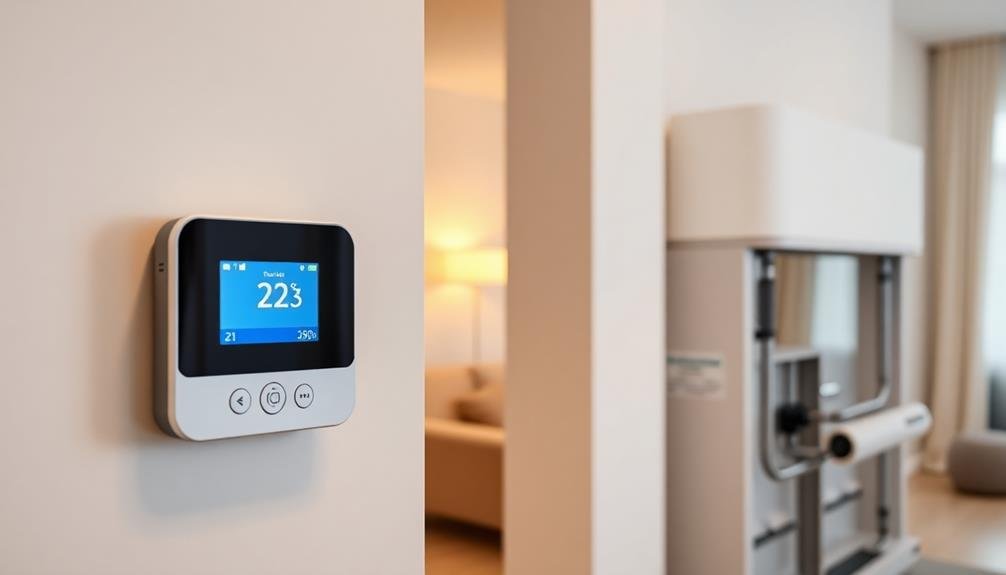
When selecting a geothermal controller for your heating automation system, you'll want to compare leading brands to find the best fit.
Consider how smart control features like remote access, energy usage tracking, and zone management can enhance your system's efficiency.
You'll find that top-performing controllers from brands like Bosch, ClimateMaster, and WaterFurnace offer advanced functionality to optimize your geothermal heating setup.
Leading Brand Comparisons
The market for geothermal heating controllers is brimming with high-quality options. When comparing leading brands, you'll find that each offers unique features and benefits.
Carrier's Infinity Control stands out for its intuitive interface and energy-tracking capabilities. It's compatible with various HVAC systems, making it versatile for different setups.
ClimateMaster's iGate Connect system boasts advanced remote access and smartphone integration. You can easily monitor and adjust your geothermal system from anywhere, providing convenience and energy savings.
WaterFurnace's Symphony web-enabled comfort platform offers similar remote functionality with the added benefit of detailed performance reports.
Bosch's Control Center thermostat excels in simplicity and reliability. It's user-friendly and provides essential control without overwhelming features.
Trane's ComfortLink II, on the other hand, offers a more robust package with zoning capabilities and weather forecasting.
For those seeking cutting-edge technology, Lennox's iComfort S30 incorporates smart home integration and learns your preferences over time. It adapts to your schedule, optimizing comfort and efficiency.
Consider your specific needs, budget, and desired features when choosing between these top-performing brands to find the best geothermal controller for your home.
Smart Control Features
Top-performing geothermal controllers offer a range of smart features that elevate home comfort and energy efficiency.
You'll find that these controllers often include Wi-Fi connectivity, allowing you to adjust settings remotely via smartphone apps. This means you can optimize your home's temperature even when you're away, ensuring comfort upon arrival and energy savings when you're out.
Many controllers now integrate with smart home ecosystems like Google Home or Amazon Alexa, enabling voice commands for temperature adjustments.
Advanced models utilize machine learning algorithms to adapt to your preferences and routines, automatically adjusting temperatures throughout the day.
You'll appreciate features like zone control, which allows for different temperature settings in various areas of your home.
Some controllers also offer energy monitoring and reporting, helping you track consumption and identify potential savings.
Weather forecasting integration is another smart feature you'll find useful. These controllers can adjust your system based on upcoming weather patterns, maximizing efficiency.
Look for models with intuitive touchscreen interfaces and customizable schedules to further tailor your geothermal system's performance to your lifestyle.
Smart Thermostat Integration Options
Smart thermostats offer three key integration options for geothermal heating automation systems.
First, you can opt for a dedicated geothermal-specific smart thermostat. These devices are designed to work seamlessly with your system, offering superior control and energy efficiency. They often include features tailored to geothermal heating, such as ground loop monitoring and heat pump cycle optimization.
Secondly, you can choose a universal smart thermostat compatible with geothermal systems. While not specifically designed for geothermal heating, these thermostats offer broad compatibility and can be programmed to work effectively with your setup. They typically provide standard features like scheduling, remote access, and energy usage reports.
Lastly, you can integrate your geothermal system with a whole-home automation platform. This option allows you to control your heating alongside other smart home devices, creating a cohesive ecosystem. You'll benefit from advanced features like geofencing, voice control, and integration with other energy management systems.
When selecting an integration option, consider factors such as compatibility with your specific geothermal system, desired features, ease of use, and long-term support.
Each option has its pros and cons, so evaluate your needs carefully to make the best choice for your home.
Energy Monitoring and Optimization Tools
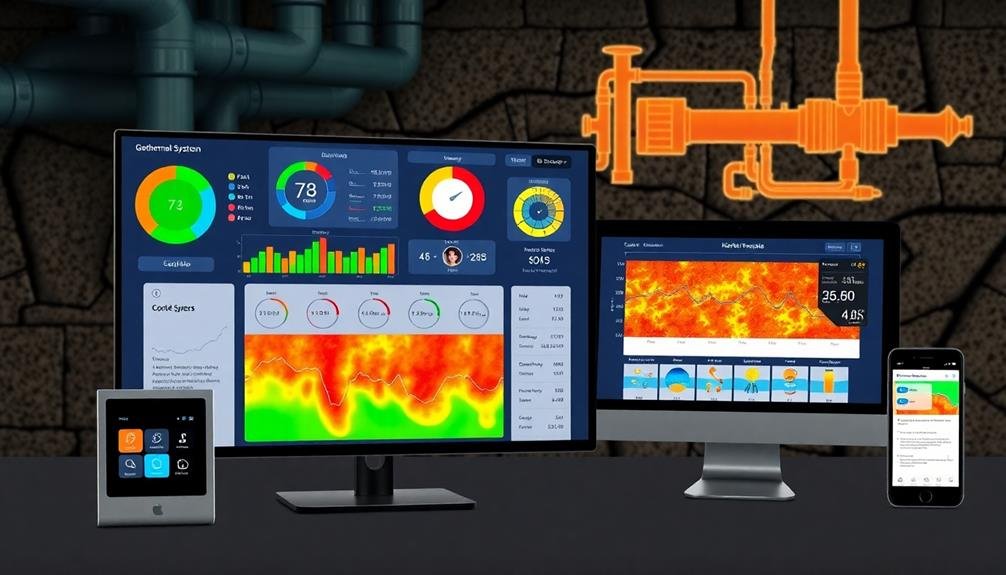
Energy monitoring and optimization tools are essential components of an efficient geothermal heating automation system. These tools provide you with real-time data on your system's performance, allowing you to make informed decisions about energy usage and cost savings.
You'll want to look for tools that offer detailed energy consumption reports, breaking down usage by time of day, week, or month. Some advanced systems even provide predictive analytics, forecasting future energy needs based on historical data and weather patterns.
Many optimization tools integrate with your smart thermostat, automatically adjusting temperatures to maximize efficiency. They can also alert you to potential system issues or maintenance needs, helping prevent costly breakdowns.
Look for tools that offer user-friendly interfaces, typically through mobile apps or web portals. These should allow you to easily view and analyze your energy data, set goals, and receive personalized recommendations for improving efficiency.
Some top options include EnergyHub, Sense, and Neurio. These platforms offer thorough monitoring and optimization features, often compatible with various geothermal systems.
Installation and Maintenance Considerations
While monitoring and optimization tools enhance your geothermal system's efficiency, proper installation and regular maintenance are key to its long-term performance.
When installing your geothermal heating automation system, verify you work with certified professionals who understand local geology and building codes. They'll determine the best loop configuration for your property and properly size the heat pump for your home's needs.
Regular maintenance is vital for peak system operation. You should schedule annual inspections to check the heat pump, antifreeze levels, and pH balance in the ground loops.
Clean or replace air filters monthly to maintain indoor air quality and system efficiency. Monitor your system's performance regularly and address any unusual noises or temperature fluctuations promptly.
Pay attention to your lawn and landscaping, avoiding deep-rooted plants near ground loops to prevent damage.
If you have a water-to-water system, test your well water quality annually. Keep outdoor components clear of debris and vegetation.
Cost-Benefit Analysis of Automation Systems
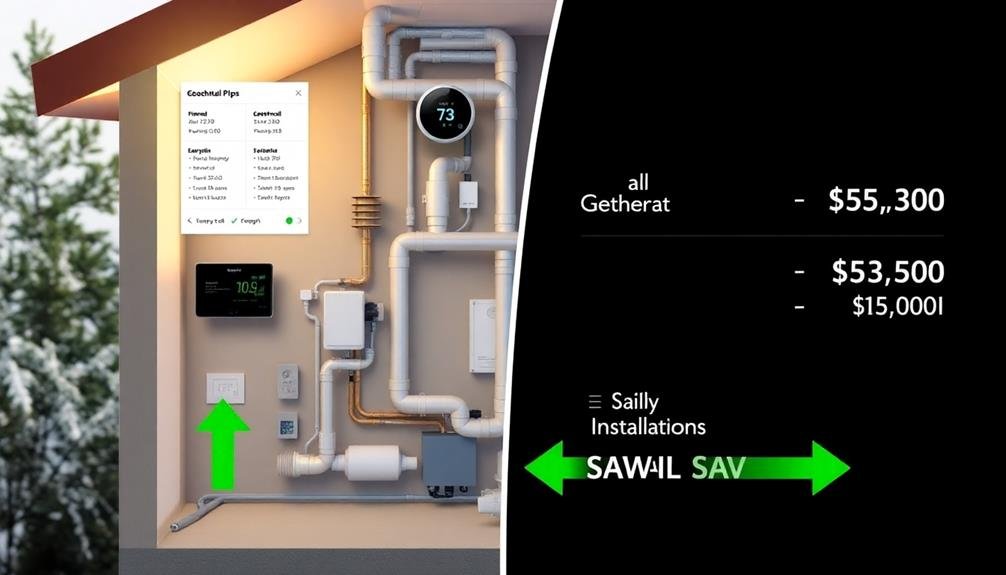
Automation's cost-benefit analysis for geothermal heating systems reveals significant long-term advantages. While initial investments may be higher, you'll see substantial savings in energy costs, improved efficiency, and reduced maintenance over time. Automated systems enhance performance, adjusting to weather conditions and occupancy patterns, resulting in lower operating costs and increased comfort.
Consider these key factors when evaluating automation systems:
| Factor | Benefit |
|---|---|
| Energy Savings | Up to 30% reduction in energy consumption |
| Maintenance Costs | Decreased by 20-40% through predictive maintenance |
| System Lifespan | Extended by 15-25% due to efficient operation |
| Comfort Level | Improved by 25-35% with precise temperature control |
| ROI | Typically achieved within 3-5 years |
You'll find that automated geothermal systems offer enhanced control over your home's climate, allowing for zone-specific adjustments and remote management. They also provide valuable data insights, enabling you to make informed decisions about your energy usage. While the upfront costs may seem overwhelming, the long-term benefits of automation in geothermal heating systems often outweigh the initial investment, making it a smart choice for homeowners looking to maximize efficiency and comfort.
Frequently Asked Questions
Can Geothermal Heating Automation Systems Work With Existing Non-Geothermal HVAC Setups?
You can integrate geothermal heating automation systems with your existing non-geothermal HVAC setup. They're designed to be versatile and compatible. You'll need to consult a professional to guarantee proper installation and best performance for your specific system.
How Does Geothermal Automation Impact Home Resale Value?
You'll likely see a boost in your home's resale value with geothermal automation. It's an attractive feature for buyers, offering energy efficiency and lower utility costs. You're investing in sustainable technology that'll pay off when selling.
Are There Government Incentives for Installing Automated Geothermal Heating Systems?
Yes, you'll find various government incentives for automated geothermal heating systems. You can benefit from federal tax credits, state rebates, and local grants. Check with your state's energy office or the Database of State Incentives for Renewables & Efficiency.
Can Geothermal Automation Systems Be Controlled Remotely via Smartphone Apps?
Yes, you can control many geothermal automation systems remotely using smartphone apps. They'll let you adjust temperature settings, monitor energy usage, and receive alerts. You'll enjoy convenient access to your system's functions from anywhere with an internet connection.
What Are the Noise Levels Associated With Automated Geothermal Heating Systems?
You'll find automated geothermal heating systems are generally quiet. They don't have outdoor units, so there's no noisy compressor. Inside, you'll hear minimal sound from the heat pump and circulation pump, similar to a refrigerator's hum.
In Summary
You've explored various geothermal heating automation options, from controllers to smart thermostats and energy monitoring tools. Now it's time to choose the system that best fits your needs and budget. Remember, the most effective setup will integrate seamlessly with your existing geothermal system, offer user-friendly controls, and provide significant energy savings. Don't forget to factor in installation and maintenance costs. With the right automation, you'll maximize your geothermal heating efficiency and enjoy long-term benefits.

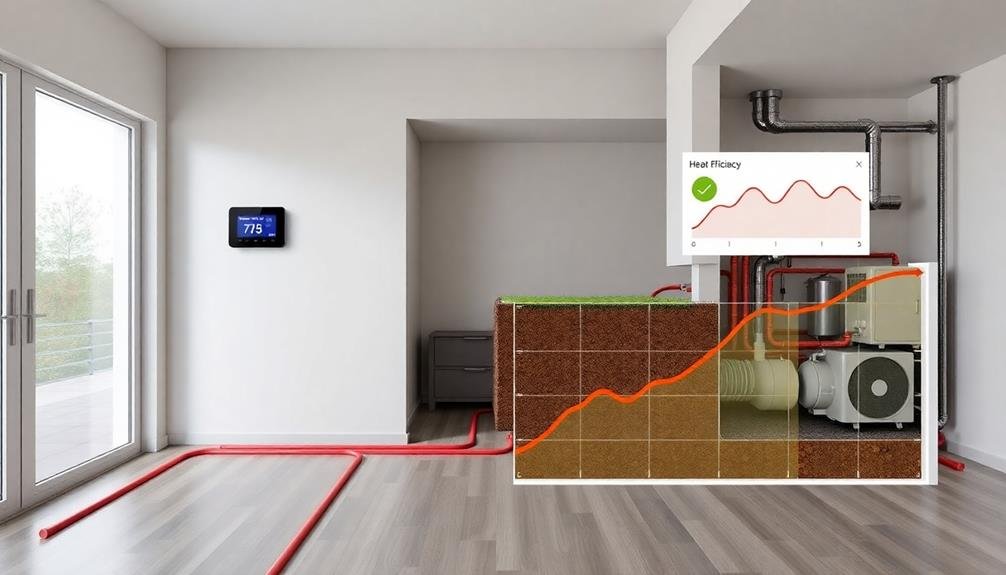



Leave a Reply